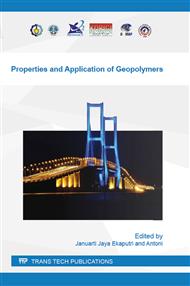p.140
p.148
p.157
p.162
p.170
p.178
p.186
p.193
p.200
Effect of Microwave Curing to the Compressive Strength of Fly Ash Based Geopolymer Mortar
Abstract:
With the advancement of technology and the economic crisis in Malaysia, has been promoting the development of infrastructure in the use of new structural materials but overall is unsatisfactory in terms of cost savings. One of the alternatives that can be used is to use fly ash as a cement replacement in manufacturing mortar. Replacement of cement with geopolymerization mortar can reduce manufacturing costs and could reduce global warming arising from the production of cement for the production of Portland cement for the release of CO2 into the atmosphere, where CO2 gas gives the largest contribution to global warming . The study will be focused on the effect of microwave curing with various durations and temperature to the mechanical and physical properties of fly ash based geopolymer mortar. For the conventional heating technique, heat is distributed in the specimen from the exterior to the interior leading to the non-uniform and long heating period to attain the required temperature. Application of microwave to the fresh concrete results in removal of water, collapse of capillary pore and densification of sample. Heat curing has been applied to construction materials especially for the precast concrete to improve the strength development process. This concrete attains sufficient strength in short curing time, so the molds can be reused, and the final products can be rapidly delivered to the site. The effect of curing temperature together with their aging days of the cured product will also be investigated. Mechanical properties of the product will be tested using compressive test, and density of the samples.
Info:
Periodical:
Pages:
193-199
Citation:
Online since:
January 2016
Keywords:
Price:
Сopyright:
© 2016 Trans Tech Publications Ltd. All Rights Reserved
Share:
Citation:


